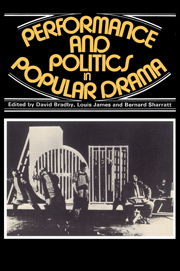 Performance and Politics in Popular Drama
Performance and Politics in Popular Drama Book contents
- Frontmatter
- Contents
- List of contributors
- Preface
- Acknowledgements
- PART ONE Spectacle, performance and audience in nineteenth-century theatre
- PART TWO Politics and performance in twentieth-century drama and film
- Introduction
- Meyerhold and Eisenstein
- Erwin Piscator's 1927 production of Hoppla, We're Alive
- Prolet Buehne: agit-prop in America
- Workers' theatre 1926–36
- The October Group and theatre under the Front Populaire
- Only the stars survive: disaster movies in the seventies
- PART THREE Problems and prospects
- Appendix: Tempo, Tempo
- Select bibliography
- General index
- Index of titles of plays, films, sketches
- Index of theatres, theatre companies and groups
Workers' theatre 1926–36
Published online by Cambridge University Press: 08 March 2010
- Frontmatter
- Contents
- List of contributors
- Preface
- Acknowledgements
- PART ONE Spectacle, performance and audience in nineteenth-century theatre
- PART TWO Politics and performance in twentieth-century drama and film
- Introduction
- Meyerhold and Eisenstein
- Erwin Piscator's 1927 production of Hoppla, We're Alive
- Prolet Buehne: agit-prop in America
- Workers' theatre 1926–36
- The October Group and theatre under the Front Populaire
- Only the stars survive: disaster movies in the seventies
- PART THREE Problems and prospects
- Appendix: Tempo, Tempo
- Select bibliography
- General index
- Index of titles of plays, films, sketches
- Index of theatres, theatre companies and groups
Summary
‘Cultural Politics’ in Britain is today very largely a preoccupation of the New Left, and the proliferation of socialist theatre groups – perhaps its most vigorous expression in recent years, and certainly the one which has made most impact on the labour movement – is peculiarly a phenomenon of the 1970s: 7:84, probably the best known of the new theatre groups, was only founded in 1971, Red Ladder in 1968, CAST (Cartoon Archetypal Slogan Theatre) around 1966. The new troupes are determinedly experimental, and insofar as any lineage is recognised at all, it does not go beyond Unity Theatre, which is vaguely associated with the 1930s, and remembered only in its moribund later years, or Joan Littlewood's Theatre Workshop, founded (with Ewan MacColl) in 1945. Yet many of the questions discussed today were burning issues for socialist theatre workers in the 1920s, in now-forgotten movements like the Workers' Theatre Movement (WTM), and the idea of a political theatre can be traced back as least to the 1900s. It played an important, if subsidiary role, in the early socialist movement (1880—1914), as also in the suffragist agitation of the time, and it is possible that diligent research may drive the frontier back still further. When – to take an instance from trade union history – the operative stone-masons employed on building the new House of Commons went on strike in 1841, they hired the Victoria theatre for a benefit, and presented a dramatised version of their case.
- Type
- Chapter
- Information
- Performance and Politics in Popular DramaAspects of Popular Entertainment in Theatre, Film and Television, 1800–1976, pp. 213 - 230Publisher: Cambridge University PressPrint publication year: 1980


